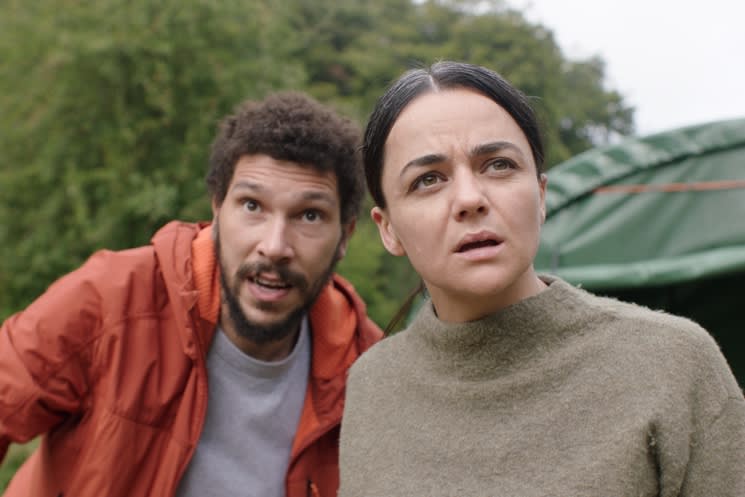Folk horror has seen a resurgence in the last few years with movies like Robert Eggers' The Witch and Ari Aster's Midsommar finding success among mainstream audiences. With In the Earth, director and writer Ben Wheatley looks to add to the genre by incorporating elements of psychological horror and using the backdrop of a pandemic.
In a world reeling from the effects of a deadly virus, Dr. Martin Lowery (Joel Fry) is guided by a park scout, Alma (Ellora Torchia), to reach a test site in the Arboreal Forest. After an attack in the middle of the night, Martin and Alma's paths cross with Zach (Reece Shearsmith), a recluse living in the woods who offers them medical assistance and refuge. It becomes clear that Zach's intentions aren't what they seem, and Martin and Alma find themselves in a battle to escape the mystic woods.
Wheatley employs psychedelic imagery as well as psychological horror elements to illustrate the seen and unseen forces preventing Martin and Alma from leaving the forest. The camera work becomes handheld and progressively frenetic as the hope of our two protagonists wanes, with some shots recalling memories of The Blair Witch Project — a film which incidentally was also influential to Wheatley's previous folk horror, Kill List.
The camera work mixed in with an incredible score by Clint Mansell builds tension and anxiety effectively elevating the horrific danger Martin and Alma are in. Fry and Torchia play their respective roles well, Torchia in particular shines as the determined and capable Alma.
Ultimately, In the Earth's notoriety rests on being a film developed, written and filmed during a worldwide pandemic. When Wheatley announced this movie last fall, he described it as a response to COVID-19, as he felt that the movies available to that point felt dated as a result of the virus.
In the Earth doesn't specifically name the disease their cinematic world is battling, but Wheatley is not subtle about making real-world comparisons. At one point, Alma and Martin discuss what the world will look like after the disease has been eradicated. Alma believes the world will move on and re-adapt to normalcy, whereas Martin believes everything has changed forever.
While Wheatley intended to reflect the we're living in today, the virus plot point feels shoehorned into the story. It does add a level of risk to Martin and Alma's initial journey, but the eventual horror of the movie has little to nothing to do with the disease. There are some interesting hints of folklore which could have benefitted from further development and better explanation. In the Earth didn't need a pandemic to be relevant or interesting.
Wheatley is well known among horror film circles and for good reason. In the Earth has some genuine moments of terror, but the loose storytelling and misguided use of COVID means that the film gets a little lost in the woods.
(Elevation Pictures)In a world reeling from the effects of a deadly virus, Dr. Martin Lowery (Joel Fry) is guided by a park scout, Alma (Ellora Torchia), to reach a test site in the Arboreal Forest. After an attack in the middle of the night, Martin and Alma's paths cross with Zach (Reece Shearsmith), a recluse living in the woods who offers them medical assistance and refuge. It becomes clear that Zach's intentions aren't what they seem, and Martin and Alma find themselves in a battle to escape the mystic woods.
Wheatley employs psychedelic imagery as well as psychological horror elements to illustrate the seen and unseen forces preventing Martin and Alma from leaving the forest. The camera work becomes handheld and progressively frenetic as the hope of our two protagonists wanes, with some shots recalling memories of The Blair Witch Project — a film which incidentally was also influential to Wheatley's previous folk horror, Kill List.
The camera work mixed in with an incredible score by Clint Mansell builds tension and anxiety effectively elevating the horrific danger Martin and Alma are in. Fry and Torchia play their respective roles well, Torchia in particular shines as the determined and capable Alma.
Ultimately, In the Earth's notoriety rests on being a film developed, written and filmed during a worldwide pandemic. When Wheatley announced this movie last fall, he described it as a response to COVID-19, as he felt that the movies available to that point felt dated as a result of the virus.
In the Earth doesn't specifically name the disease their cinematic world is battling, but Wheatley is not subtle about making real-world comparisons. At one point, Alma and Martin discuss what the world will look like after the disease has been eradicated. Alma believes the world will move on and re-adapt to normalcy, whereas Martin believes everything has changed forever.
While Wheatley intended to reflect the we're living in today, the virus plot point feels shoehorned into the story. It does add a level of risk to Martin and Alma's initial journey, but the eventual horror of the movie has little to nothing to do with the disease. There are some interesting hints of folklore which could have benefitted from further development and better explanation. In the Earth didn't need a pandemic to be relevant or interesting.
Wheatley is well known among horror film circles and for good reason. In the Earth has some genuine moments of terror, but the loose storytelling and misguided use of COVID means that the film gets a little lost in the woods.
